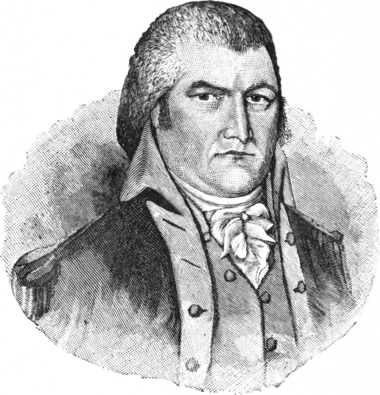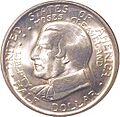Moses Cleaveland facts for kids
Quick facts for kids
Moses Cleaveland
|
|
|---|---|

General Moses Cleaveland
|
|
| Born | January 29, 1754 |
| Died | November 16, 1806 (aged 52) Canterbury, Connecticut, U.S.
|
| Known for | Founder of Cleveland, Ohio |
| Signature | |
Moses Cleaveland (born January 29, 1754 – died November 16, 1806) was an American lawyer, politician, soldier, and land surveyor. He is famous for founding the city of Cleveland, Ohio. He did this in 1796 while exploring and mapping a large area of land called the Connecticut Western Reserve. During the American Revolution, he was a high-ranking officer in the Connecticut militia.
Contents
Early Life and Military Service
Moses Cleaveland was born in Canterbury, a town in what was then the Connecticut Colony. His parents were Colonel Aaron Cleaveland and Thankful Cleaveland. He went to Yale College, which is now Yale University. He studied law there and graduated in 1777.
During the American Revolution, Moses Cleaveland joined the army. He became an ensign, a junior officer, in the Continental Army in 1777. Later, in 1779, he was promoted to captain. He led a special group of "sappers and miners," who were like combat engineers. They helped build things or break down enemy defenses. He left the army in 1781 and started working as a lawyer in Canterbury.
A Leader in Connecticut
Moses Cleaveland was an important person in Connecticut. He was part of a special meeting that approved the United States Constitution. This document is the main law of the United States. He was also elected many times to the state's government, called the Connecticut General Assembly. In 1796, he became a brigadier general in the state militia.
He also owned shares in a group called the Connecticut Land Company. This company bought a huge piece of land in what is now northeastern Ohio. They paid $1,200,000 for it. This land was originally set aside for Connecticut by the U.S. Congress. It was first called New Connecticut, but later became known as the Western Reserve.
Leading the Western Reserve Expedition
In May 1796, the directors of the Connecticut Land Company asked Moses Cleaveland to lead an important trip. His job was to survey the land and find good spots for new settlements. He also had to talk with the Native American tribes living on the land.
In June 1796, Cleaveland and his group set out from Schenectady, New York. There were about 50 people on the trip. This included six surveyors, a doctor, a chaplain, and many workers. A few families also came along. Some people traveled by land with horses and cattle. The main group went by boat. They traveled up the Mohawk River, then down the Oswego River. They went along the shore of Lake Ontario and up the Niagara River. They even had to carry their boats for seven miles around Niagara Falls.
Founding the City of Cleveland
When Cleaveland's group reached Buffalo, they met with leaders from the Mohawk and Seneca tribes. These tribes did not want the group to enter the Western Reserve. They said it was their land. But after receiving gifts worth $1,200, they allowed the expedition to continue.
The group then traveled along the shore of Lake Erie. On July 4, 1796, they landed at the mouth of Conneaut Creek. They named this spot Port Independence. Native Americans nearby were still worried about people moving onto their land. But they were calmed with gifts like beads and whiskey, and the surveys were allowed to begin.
On July 22, 1796, General Cleaveland and his surveying team landed at the mouth of the Cuyahoga River. He climbed the riverbank and decided this was a great place for a city. It had the river on one side and Lake Erie on the other. He had the area mapped out into town lots. His employees decided to name the new place "Cleaveland" in his honor.
At first, growth was slow. Only four settlers lived there in the first year. By 1820, there were only 150 people. Moses Cleaveland returned home to Connecticut after this expedition in 1796. He never visited Ohio or the city named after him again. He died and was buried in Canterbury, Connecticut. However, a statue of him stands in Cleveland Public Square.
How "Cleaveland" Became "Cleveland"
The settlement was first spelled "Cleaveland." One idea is that Cleaveland's own surveyors misspelled the name on their first map. However, a more likely story comes from an early local newspaper called the Cleveland Advertiser. The newspaper couldn't fit "Cleaveland Advertiser" on its front page. So, they dropped the extra "a" to save space, and the new spelling, "Cleveland," stuck!
Moses Cleaveland Trees
Moses Cleaveland is remembered not just by the city's name, but also by special trees. These are called Moses Cleaveland Trees and are found around the Greater Cleveland area. In 1946, for the 150-year anniversary of Moses Cleaveland's arrival, a scientist named Arthur B. Williams had an idea. He suggested finding and labeling trees that were already alive when Cleaveland first came to the area.
In 1946, 242 trees of 23 different types were suggested to become official Moses Cleaveland Trees. Each tree's age was checked. The list was then shortened to 150 trees that people could easily visit. Each of these trees received a special metal plaque. It identified them as one of the Moses Cleaveland Trees. Since then, more trees have been added to the list, especially as some of the original ones have died. As of 2024, there are about 270 Moses Cleaveland Trees.
Commemorations
-
Gen. Moses Cleaveland statue sculpted by James G. C. Hamilton located on Public Square in downtown Cleveland.



